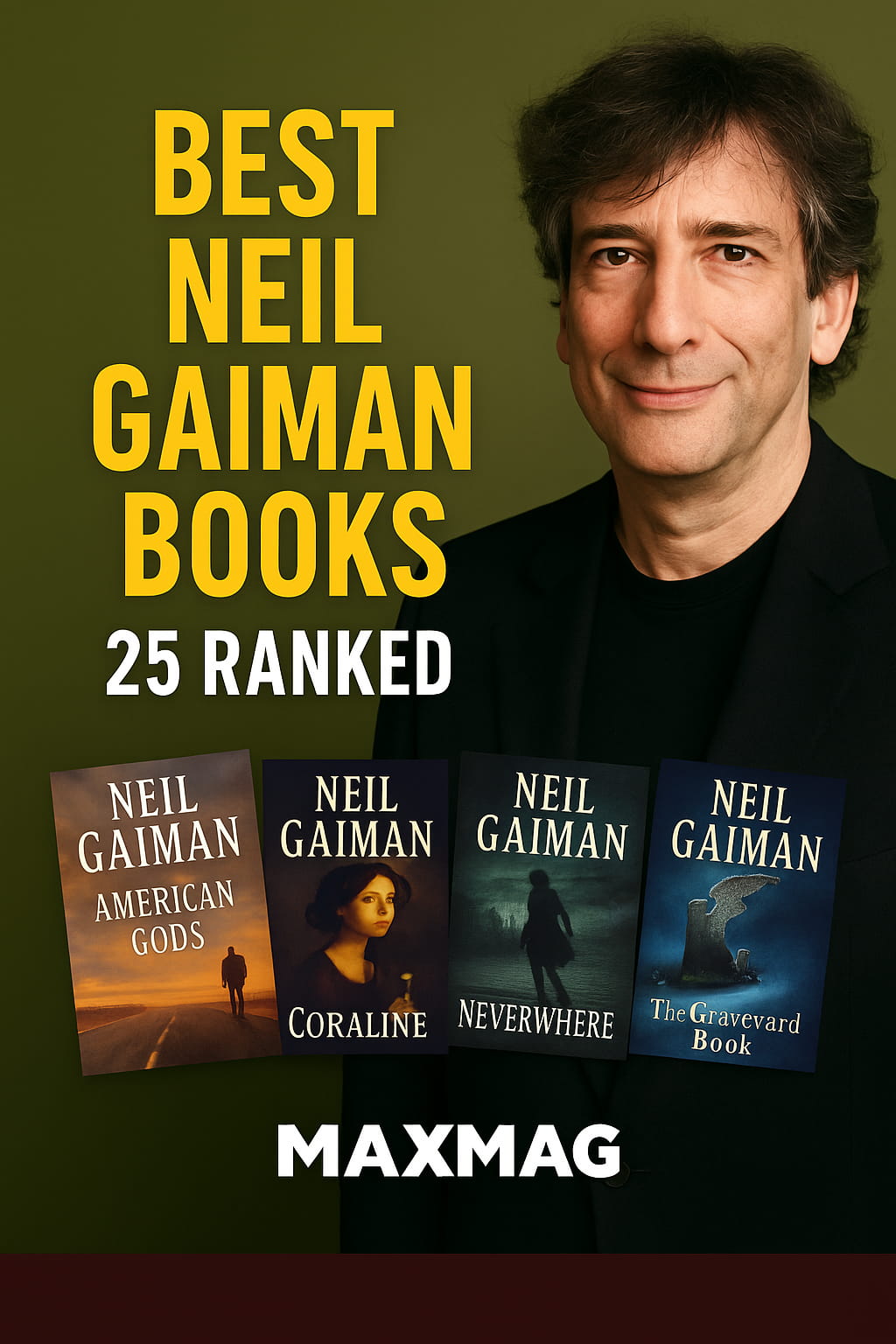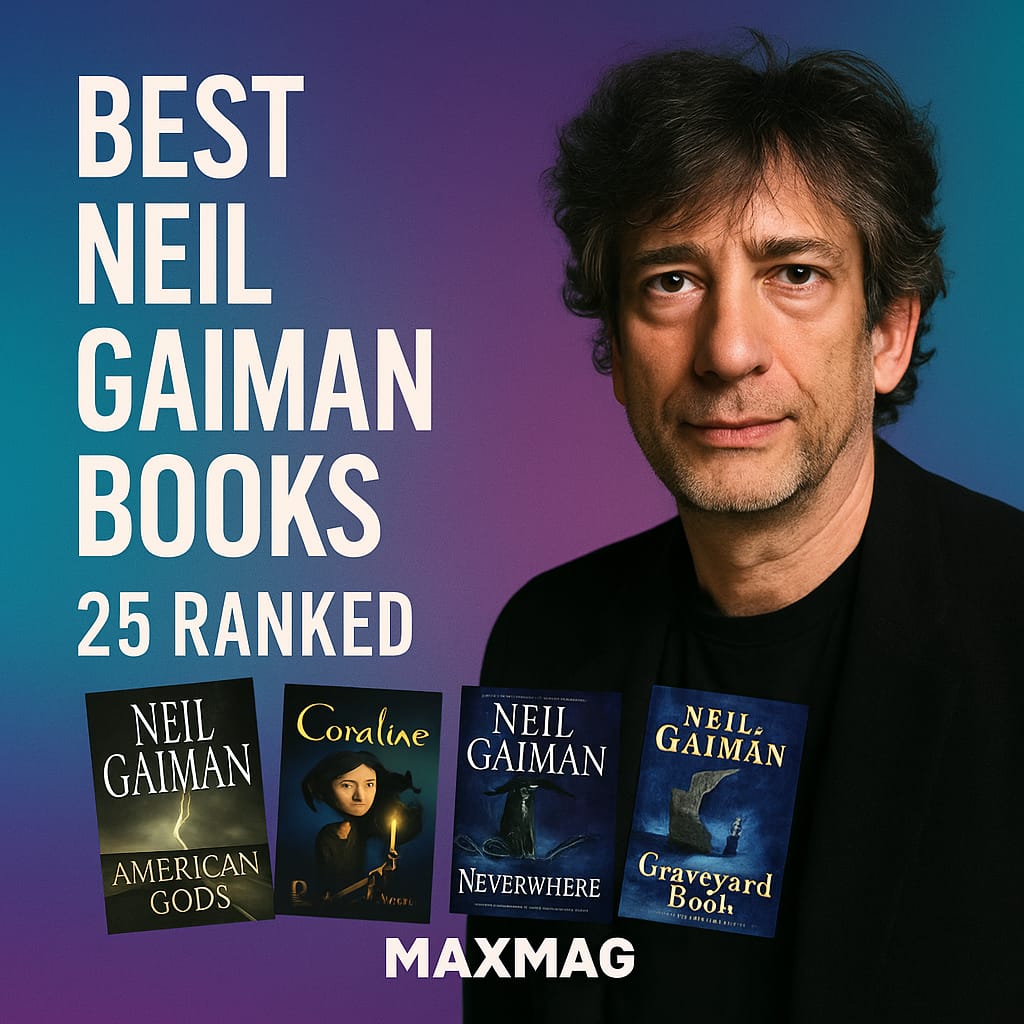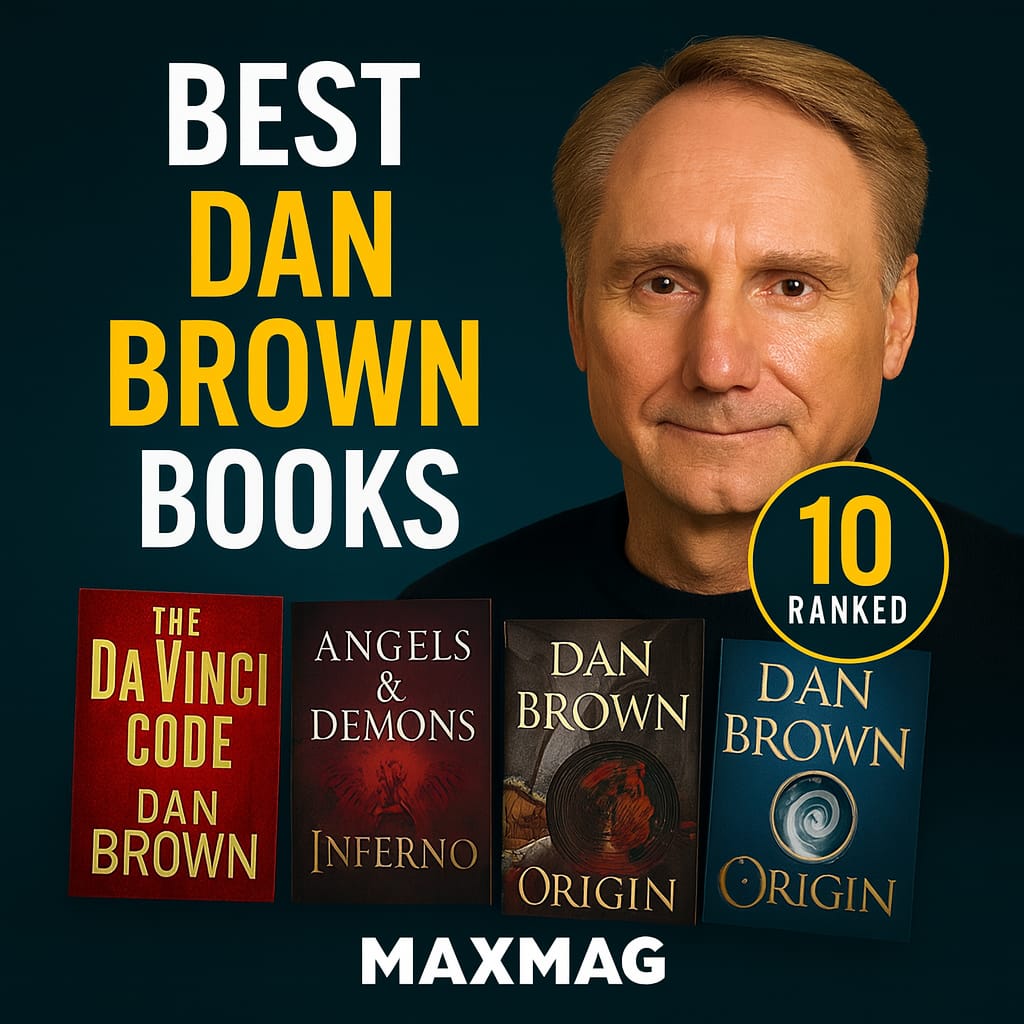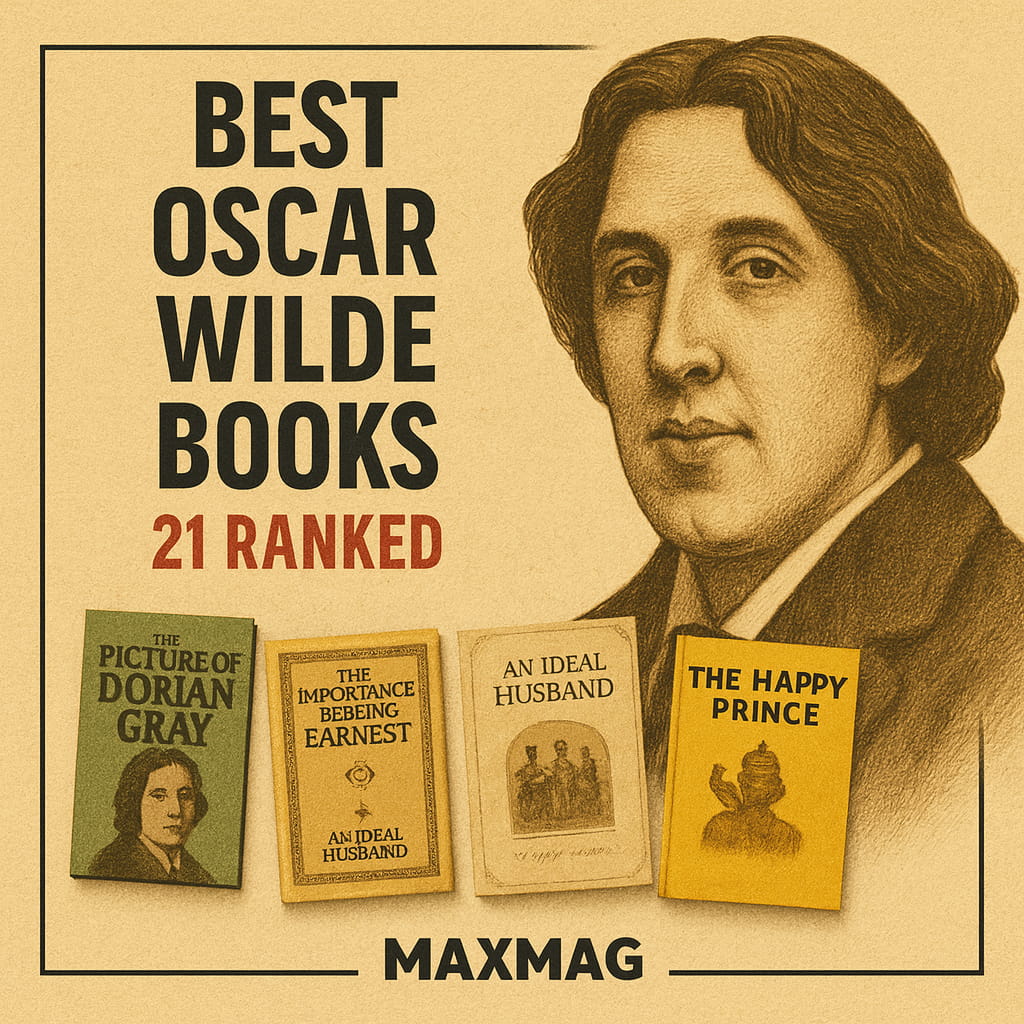
Across fiction and comics alike, readers often discover the Best Neil Gaiman Books through a single unforgettable gateway. Neil Richard Gaiman is an English writer from Portchester, Hampshire, whose work spans novels, comics, short fiction, children’s picture books, radio, and screenwriting. He is widely known for The Sandman cycle in comics and prose standouts such as American Gods, Coraline, Neverwhere, Stardust, and The Graveyard Book. His career stretches from the mid-1980s to the present, crossing audiences and formats with ease. He publishes on both sides of the Atlantic and maintains a detailed official site. His bibliography includes dark fantasy, myth retellings, urban fantasy, and gothic children’s tales. Two titles often cited first by new readers are Coraline and American Gods. For an at-a-glance background, see the author’s brief biographical note on his official website (About Neil).
Public recognition grew in two waves: first with The Sandman in comics, then with the bestseller American Gods and other prose novels that reached large global audiences. Breakout visibility came from television and film adaptations as well, while picture books and short-story collections kept expanding his readership. The hallmarks are folklore, gods among mortals, parallel Londons, haunted houses, and tricksters who complicate human choices. This guide presents 25 titles and keeps the tally strictly about plots and reader response. It focuses on core works across forms while respecting a rating floor. The sequencing below is a ratings-led climb, finishing with consensus favorites. Here, we use the phrase Best Neil Gaiman Books in a precise way: a list filtered for eligibility and sorted by public ratings.
25 Best Neil Gaiman Books in a Rising Rating Order
Methodology & Updates
Sources include public reader averages captured on October 19, 2025, with Goodreads as the primary benchmark; ties are broken by earlier publication year, then A–Z by title. Ratings can shift over time as more readers vote; positions may therefore adjust in future updates.
#1) The Tragical Comedy or Comical Tragedy of Mr. Punch – 1994
- Author: Neil Gaiman
- Published: 1994
- Work Type / Genre Tags: graphic novel; psychological; folklore
- Themes: memory; betrayal; family secrets
- Goodreads Rating: 3.76/5
A boy in a seaside English town remembers dawn fishing trips, puppet booths, and a mysterious Punch-and-Judy man. An unsettling family past pushes itself into view as grown-ups speak around what really happened. The narrator’s goal becomes understanding how a childhood world of make-believe shadows real harm. Grandparents, a hunchbacked relative, and a troubling incident at a beach cave shape the inquiry. The show’s violent beats echo through domestic scenes until cause and effect blur. Clues about a betrayal and a missing child accumulate, reframing the adults’ silences. The confrontation builds toward an internal reckoning rather than a public confession. The last movements leave the story’s consequences lodged in what the narrator can and cannot remember.
#2) M Is for Magic – 2007
- Author: Neil Gaiman
- Published: 2007
- Work Type / Genre Tags: short story collection; fantasy; YA-friendly
- Themes: curiosity; bargains; growing up
- Goodreads Rating: 3.81/5
The collection opens doors to sideways worlds in bite-size tales, each with its own cast and setting. One story follows a boy who learns how not to talk to aliens at a party. Another places a retired knight’s thrift-shop grail on a suburban mantel. A noir investigation begins when a cat’s nightly battles hint at something prowling the garden. Children negotiate with witches, old houses, and rules that bend if a price is paid. A would-be hero finds quests hiding in ordinary streets and school corridors. Ghosts and guardians stand in doorways, warning and inviting at once. Climaxes come quietly, through choices made at kitchen tables or on dark lanes. Endings leave characters changed by the oddities they dared to entertain.
#3) Signal to Noise – 1992
- Author: Neil Gaiman
- Published: 1992
- Work Type / Genre Tags: graphic novel; metafiction; drama
- Themes: mortality; art-making; apocalypse
- Goodreads Rating: 3.84/5
A London filmmaker learns he is dying and imagines the last movie he will never shoot. His unwritten film takes place in the year 999, as villagers face an ending they do not understand. He wants to tell their story before his time runs out. Colleagues, lovers, and producers orbit him as he scripts scenes in cafés and hospital rooms. Interruptions and hospital tests complicate the filmic daydream and the real day-to-day both. The imagined villagers prepare rituals and reckon with fear, mirroring the creator’s countdown. A final sequence converges the editing room of the mind with an invented apocalypse. The closing image accepts that some stories exist only in the act of being told.
#4) The Sleeper and the Spindle – 2014
- Author: Neil Gaiman
- Published: 2014
- Work Type / Genre Tags: illustrated novella; fairy-tale remix
- Themes: autonomy; awakening; enchantment
- Goodreads Rating: 3.87/5
A young queen preparing for marriage hears of a sleeping sickness creeping over the mountains. She postpones her wedding, arms herself, and sets out with three dwarf companions. Her aim is to reach the source of the spell and wake the land. The road threads through towns clogged with cobwebbed sleepers and a castle crusted in thorn. A silent court holds a girl on a bed, while an older woman watches and waits. Hidden motives surface as identities trade places and the story’s roles invert. The confrontation stirs a different kind of awakening and an unexpected freedom. The queen leaves with a decision that keeps the horizon open.
#5) Trigger Warning – 2015
- Author: Neil Gaiman
- Published: 2015
- Work Type / Genre Tags: short story collection; horror; fantasy
- Themes: thresholds; memory; uncanny encounters
- Goodreads Rating: 3.91/5
The anthology gathers tales where ordinary settings tilt into menace or wonder. One story finds a traveler walking into a roadside inn where an old god still takes meetings. Another follows a couple up a stairwell where a child’s bedtime monster negotiates terms. A man confronts a person from his past who may never have existed. A familiar wanderer named Shadow drifts into a village and accepts a dangerous errand. A calendar of months becomes a string of fables about time and weather. A detective story examines a killing that will not stay in one tidy genre. The volume’s climaxes hinge on quiet decisions, not flourishes. Endings leave doorways ajar, suggesting more footsteps after the page turns.
#6) Fragile Things – 2006
- Author: Neil Gaiman
- Published: 2006
- Work Type / Genre Tags: short story collection; fabulism; gothic
- Themes: desire; loss; masks
- Goodreads Rating: 3.95/5
Stories here treat crossroads as places where bargains look like luck. Two boys step into the wrong neighborhood party and discover it is not for them. A traveler hears a murder described by an angel who remembers too vividly. A man purchases curious objects that tug him toward a Grail hiding in plain sight. A dreamlike October meeting becomes a parliament of months discussing an unruly child. Elsewhere, a stage magician’s finale turns on the oldest misdirection of all. Plots push characters to admit what they want and what it costs. Endings often turn on a single object, a last look, or a name said aloud.
#7) Odd and the Frost Giants – 2008
- Author: Neil Gaiman
- Published: 2008
- Work Type / Genre Tags: novella; mythic fantasy; middle-grade
- Themes: courage; winter; wit versus strength
- Goodreads Rating: 3.98/5
In a Norse village locked in ice, a limping boy named Odd meets a fox, an eagle, and a bear with secrets. They reveal themselves as gods trapped in animal form by a usurping frost giant. Odd decides to help them return to Asgard and end the winter that will not leave. The road north leads through forests, mountains, and a rainbow bridge in jeopardy. The trio’s frayed friendship complicates their rescue attempt. In the giant’s hall, Odd stakes everything on courtesy, riddles, and leverage. The standoff points toward a swap that resets the balance without a sword drawn. Spring follows, and the boy walks home with a new way of meeting the world.
#8) The Truth Is a Cave in the Black Mountains – 2014
- Author: Neil Gaiman
- Published: 2014
- Work Type / Genre Tags: illustrated novella; dark folktale
- Themes: vengeance; greed; consequence
- Goodreads Rating: 3.98/5
A small, determined man hires a taller guide to lead him to a Hebridean cave said to contain gold. He claims he wants wealth, but he truly seeks someone who disappeared. The guide suspects a trap yet follows the path across moor and sea. Stories traded by the fire sketch lost children, a thief’s pupil, and a debt left unpaid. The cave is reached on an island where riches demand a price in years. Suspicion hardens into recognition as the men approach the hoard. The final confrontation turns a journey for treasure into a reckoning long deferred. Wind and tide carry the aftermath back toward the mainland, but not toward peace.
Early Currents of the Best Neil Gaiman Books

#9) The Day I Swapped My Dad for Two Goldfish – 1997
- Author: Neil Gaiman
- Published: 1997
- Work Type / Genre Tags: picture book; family comedy
- Themes: consequences; barter; responsibility
- Goodreads Rating: 3.99/5
A boy trades his dad to a friend in exchange for two goldfish. He returns home to discover that his mother expects the dad back for dinner. The quest to reverse the swap sends him through a chain of neighbors and new trades. Each house adds another funny misunderstanding and a new owner who wants to keep what they got. The boy partners with his little sister to track the original deal across town. Apologies, promises, and creative bargaining unwind the mess in reverse. The journey turns a joke into a lesson about what can and cannot be traded. Everyone ends up where they belong, including the goldfish.
#10) Smoke and Mirrors – 1998
- Author: Neil Gaiman
- Published: 1998
- Work Type / Genre Tags: short story collection; fairy-tale inversion; horror
- Themes: temptation; myth; retold histories
- Goodreads Rating: 4.01/5
Opening pieces set up ordinary people who step sideways into older stories. One tale rewrites a mirror-bright fairy tale from the queen’s side of the glass. Another tracks a knight who finds the Grail at a charity shop and must decide what to do next. A Hollywood fable explains what angels see when they recall a crime no court could try. Elsewhere, a poet’s marriage buckles under a single wrong gift. A seaside honeymoon tightens into dread with the arrival of too many cats. Scenes advance toward brief, stinging reversals rather than long battles. Final images ask whether the trick was the world or the reader’s assumptions all along.
Later-Middle Turns in the Best Neil Gaiman Books
#11) The Ocean at the End of the Lane – 2013
- Author: Neil Gaiman
- Published: 2013
- Work Type / Genre Tags: novel; dark fantasy; memory tale
- Themes: childhood; sacrifice; memory’s edits
- Goodreads Rating: 4.01/5
A man returns to a rural lane for a funeral and wanders to a farmhouse he dimly recalls. Childhood floods back: a lodger’s death, a hole opened between worlds, and a girl named Lettie Hempstock. The boy he was agrees to help fix a problem let into the fields. An intrusive caretaker named Ursula makes the house feel smaller and the rules bend. The Hempstocks guide him through night water, string, and scissors that cut more than thread. A final stand at the pond asks for a promise no child should have to weigh. Years later, the visitor learns what memory removed to let him go on.
#12) The Wolves in the Walls – 2003
- Author: Neil Gaiman
- Published: 2003
- Work Type / Genre Tags: picture book; domestic gothic
- Themes: fear; bravery; home reclaimed
- Goodreads Rating: 4.03/5
Lucy hears scratching and whispering inside the walls but no one believes her. One night, wolves burst out and run the family from the house. The family camps in the garden and tries to decide where to live next. Lucy wants to take back the place that holds her things and stories. She sneaks in, scouts, and finds the wolves distracted by jam and music. Her plan rallies the family to move from hiding to action. A noisy surprise routs the intruders without a chase. The house becomes theirs again, though Lucy still listens for new sounds.
#13) Anansi Boys – 2005
- Author: Neil Gaiman
- Published: 2005
- Work Type / Genre Tags: novel; mythic contemporary; trickster tale
- Themes: family; identity; inheritance
- Goodreads Rating: 4.04/5
Charlie Nancy lives quietly until his father dies and a brother he never knew appears. The brother, who calls himself Spider, can pull tricks that bend reality. Charlie’s life and engagement veer off course as Spider borrows his face and luck. Old stories about the spider-god Anansi begin to press against modern London and Florida. A dangerous rival linked to Tiger wakes grudges older than either brother. Allies from islands and nightclubs gather as a plan takes shape. A showdown tests which brother can hold a story without breaking it. The result rearranges what each man thinks his name means.
#14) Fortunately, the Milk – 2013
- Author: Neil Gaiman
- Published: 2013
- Work Type / Genre Tags: chapter book; comic adventure; time travel
- Themes: parenting; tall tales; perseverance
- Goodreads Rating: 4.05/5
A dad pops out to buy milk for breakfast and returns very late with a story. He claims he was abducted by aliens, rescued by a stegosaurus in a hot-air balloon, and nearly fed to pirates. His immediate objective is keeping the milk safe while reality keeps tilting. A jewel-eyed god in a volcano insists on a ritual, then a time loop scrambles where the carton should be. The dinosaur-pilot charts a route through a cloud of piranhas and a meeting with inventor-worshipping dwarfs. The dad’s improvised plans keep family breakfast in mind despite chaos. The tale ends at a kitchen table where the milk finally meets cereal, and the kids decide what to believe.
#15) The Sandman: Overture – 2015
- Author: Neil Gaiman
- Published: 2015
- Work Type / Genre Tags: graphic novel; cosmic fantasy
- Themes: duty; consequence; origins
- Goodreads Rating: 4.05/5
Before the long captivity that begins his saga, Dream senses a wrongness moving across the cosmos. A star has gone mad, and a version of himself that is not quite him attempts a warning. He sets out through realms of flowers, cats, and places where stories begin. Siblings and old allies appear in strange forms as a council assembles. The investigation uncovers an earlier failure that still radiates harm. To repair it, Dream must carry a burden only he can lift. The culmination threads choices that will make him vulnerable to the trap readers know is coming. The last images slide the prelude into the opening frame of the larger tale.
#16) Stardust – 1999
- Author: Neil Gaiman
- Published: 1999
- Work Type / Genre Tags: novel; fairy romance; quest
- Themes: promises; fate; crossing thresholds
- Goodreads Rating: 4.10/5
In the village of Wall, Tristran Thorn vows to fetch a fallen star for a girl he thinks he loves. He slips through a gap into Faerie and discovers the star is a woman named Yvaine. His first problem is getting her across contested lands without losing her or his word. Princes hunt for a power-granting jewel, and witches want what a star’s heart can give. Traveling companies and inns at cross-roads complicate who can be trusted. Clues suggest Tristran misjudged what he truly promised and to whom. A final return to the wall asks him to choose where he belongs. The story ends with a life measured in constellations rather than streets.
Momentum Builds toward the Best Neil Gaiman Books

#17) American Gods – 2001
- Author: Neil Gaiman
- Published: 2001
- Work Type / Genre Tags: novel; road myth; contemporary fantasy
- Themes: belief; migration; loyalty
- Goodreads Rating: 4.10/5
Shadow Moon leaves prison early and meets Mr. Wednesday, who offers a job that is not quite defined. A cross-country itinerary introduces gods carried to America by believers and new powers born of screens and markets. Shadow’s first aim is survival, then understanding the war he has entered. A lakeside town hides a seasonal secret while con men play longer games. Old allies gather in motel rooms and at roadside attractions to pick sides. Clues reveal that the conflict’s terms are not what either camp believes. The climax redirects a planned battle into a different accounting. Afterward, Shadow decides how to live with what he has learned about names and debts.
#18) Norse Mythology – 2017
- Author: Neil Gaiman
- Published: 2017
- Work Type / Genre Tags: myth retellings; prose cycle
- Themes: trickery; honor; endings and renewals
- Goodreads Rating: 4.10/5
The book retells episodes from the Norse gods’ lives, starting with creation and finishing at Ragnarök. Odin seeks wisdom, Thor solves disputes with a hammer, and Loki turns problems into bigger problems. Each chapter stands alone but threads forward through feasts, wagers, and bride-thefts. Treasures are forged underground while frost and fire argue about the world’s shape. Giants challenge bargains, and oaths bind tighter than chains. The middle stretch follows thefts, quests, and practical jokes with consequences. Final chapters describe the last battle and what may come after the ruin. The sequence closes with a sense that stories make endings bearable.
#19) Coraline – 2002
- Author: Neil Gaiman
- Published: 2002
- Work Type / Genre Tags: novella; dark fantasy; children’s
- Themes: bravery; identity; home and “other” home
- Goodreads Rating: 4.13/5
Coraline Jones moves into a big old house divided into flats and starts exploring. A door opens to an apartment that looks like hers but belongs to another mother and father. She wants attention and adventure, then realizes the price is buttons where eyes should be. Talking cats, trapped ghosts, and a snarky theater troupe offer warnings in riddles. Coraline must bargain cleverly, choosing words that bind instead of break. A game of find-and-seek locks her into a timetable she cannot miss. The final run home requires nerve and a thread she can trust. Loose ends tie up with a tea party that feels earned.
#20) The Graveyard Book – 2008
- Author: Neil Gaiman
- Published: 2008
- Work Type / Genre Tags: novel; coming-of-age; gothic
- Themes: family of choice; growing up; safety versus freedom
- Goodreads Rating: 4.15/5
After a tragedy, a toddler wanders into a graveyard and is adopted by its residents. The boy, called Bod, learns from ghosts, a guardian, and a witch who lost her headstone. His first aims are simple: lessons, friends, and staying out of sight of the man who wants him dead. Field trips to school and a dance with the living complicate the rules. Clues lead Bod to old orders and a name that hunts in packs. The conflict tightens through catacombs, a pawnshop, and a cairn that hides a door. A showdown under the hill closes one life chapter and opens another. At the end, Bod leaves the graveyard to make a world of his own.
#21) Neverwhere – 1996
- Author: Neil Gaiman
- Published: 1996
- Work Type / Genre Tags: novel; urban fantasy; quest
- Themes: compassion; invisibility; promises
- Goodreads Rating: 4.16/5
Richard Mayhew stops to help a bleeding girl on a London sidewalk and drops out of his old life. He follows Door into London Below, where markets move and angels give directions you should not trust. Richard hopes only to get home, but the killers Croup and Vandemar change his options. A bodyguard called Hunter joins their search for who murdered Door’s family. Tunnels, floating markets, and a bridge with a price test their nerve. An angel’s assignment sends them deeper, toward a key that does not open what it seems. The final confrontation binds a promise made in a corridor to a decision at a doorway. Richard chooses which London is truly his.
The Crest of the Best Neil Gaiman Books
#22) A Study in Emerald – 2003
- Author: Neil Gaiman
- Published: 2003
- Work Type / Genre Tags: short story; Holmes/Lovecraft pastiche
- Themes: empire; inversion; secrecy
- Goodreads Rating: 4.16/5
In a Victorian city ruled by inhuman royalty, a consulting detective takes a bloody case. A wounded veteran narrates as clues point toward political theater and forbidden worship. Their immediate goal is catching a killer before palace agents do. Newspaper scrapbooks and coded advertisements widen the hunt’s map. A secret society and a stage magician’s act add misdirection that actually clarifies motive. A last-minute reveal flips which side is law and which is revolt. The case concludes with a solution that must never be printed. Readers can consult an authorized text online (full story PDF).
#23) Blueberry Girl – 2009
- Author: Neil Gaiman
- Published: 2009
- Work Type / Genre Tags: picture book; blessing poem
- Themes: guardianship; growth; wonder
- Goodreads Rating: 4.18/5
Voices of three protectors speak to a girl as she moves through seasons of a life. They ask for safe travels on roads and in rooms full of books. Their hope is that mistakes teach, not break. Images show classrooms, storms, and fields where she will choose her steps. The prayer requests friends who are true and hands that help. It grants curiosity and stubbornness enough to become herself. A closing wish gathers courage for days when skies are not kind. The page turns on blessings that walk beside her, unseen but present.
#24) Good Omens (with Terry Pratchett) – 1990
- Author: Neil Gaiman
- Published: 1990
- Work Type / Genre Tags: novel; apocalyptic comedy; partnership
- Themes: free will; prophecy; unlikely alliances
- Goodreads Rating: 4.25/5
An angel named Aziraphale and a demon named Crowley misplace the Antichrist at birth. Years later, the wrong boy grows up in an English village with a gang who call themselves the Them. The initial objective is simple: avert the end of the world without telling head office. Prophecies by Agnes Nutter point to a small town on a specific Saturday. Witchfinders, bikers, and a descendant of a prophet converge on the same crossroads. The Four Horsemen rev engines instead of saddling up. The final moves test whether a child can refuse a destiny grown-ups wrote. The world survives or ends on a choice made in a playground.
#25) The Sandman: The Dream Hunters – 1999
- Author: Neil Gaiman
- Published: 1999
- Work Type / Genre Tags: illustrated novella; mythic romance
- Themes: sacrifice; deception; devotion
- Goodreads Rating: 4.41/5
A fox spirit falls in love with a humble monk after overhearing a plot against him. She trades places with a human woman, taking on the danger meant for the monk. His aim becomes finding who spun the curse and how to unbind it. Dream appears at a temple, a court, and in the hush between breaths. A jealous noble and a hired magician draw the lovers into layered illusions. The monk journeys into the realm of dreams to bargain for a life. The climax asks who will pay and how much is enough. A final quiet scene decides whether love can hold against the rules of stories.
Neil Gaiman: Career at a Glance
Neil Gaiman (born 1960, Portchester, Hampshire) emerged in the late 1980s writing comics and journalism before a long run redefining modern fantasy in multiple forms. His work spans graphic novels (The Sandman), novels (American Gods, Anansi Boys, Neverwhere, Stardust, The Ocean at the End of the Lane), children’s and YA books (Coraline, The Graveyard Book, Fortunately, the Milk), and mythic retellings (Norse Mythology). Signature ideas include hidden worlds alongside our own, trickster bargains, and hauntings of memory, all visible across the Best Neil Gaiman Books and their adaptations. Honors include major genre and children’s awards, and his stories continue to seed film and television. He collaborates frequently with illustrators such as Dave McKean and Chris Riddell. Generations of writers cite his hybrid approach—mixing folklore, comics grammar, and literary craft—as a permission slip to cross formats. The resulting shelf shows a career both restless and coherent, with touchstones accessible to new readers and re-readers alike.
Conclusion
This guide gathered 25 titles across three decades, moving from early experiments and short-form collections to established novels and beloved picture books. The ranking shows a steady rise from curios and deep cuts to widely agreed peaks, mapping a path newcomers can follow at a glance through the Best Neil Gaiman Books. For an educational overview in the public record, see the U.S. Library of Congress National Book Festival feature on Gaiman discussing The Graveyard Book (Library of Congress blog), which situates the author among contemporary children’s and fantasy voices.
Across these entries, recurring subjects—tricksters, thresholds, found families, and the uneasy overlap of myth and suburbia—play out in cities, graveyards, puppet booths, and other houses that are not quite home. Together they illustrate how the Best Neil Gaiman Books braid folklore with present-day lives while leaving room for mystery. For a journalistic context that tracks his broader impact and public persona, see The New Yorker’s long profile (“Kid Goth”) on his cross-format career (New Yorker profile).
FAQ: What to know about the Best Neil Gaiman Books
Q1: How did you decide which titles belong on a list of the Best Neil Gaiman Books?
Q2: Where should a new reader start with the Best Neil Gaiman Books?
Q3: Why include picture books and graphic novels among the Best Neil Gaiman Books?
Q4: What’s the difference between American Gods and Anansi Boys within the Best Neil Gaiman Books?
Q5: Which titles are most suitable for children among the Best Neil Gaiman Books?








